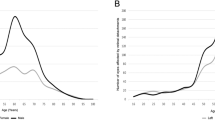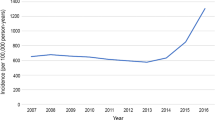Abstract
Purpose
Retinopexy is the most common vitreo-retinal procedure performed in the eye emergency department and significantly reduces the risk of a rhegmatogenous retinal detachment (RRD). There are various indications for retinopexy, with the most common being horseshoe-tears (HST). Multiple treatment techniques exist, ranging from slit-lamp laser-retinopexy, indirect laser-retinopexy or cryopexy. We report on our primary retinopexy 6-month RRD rate, repeat retinopexy rate and compare outcomes of different indications and treatment modalities.
Methods
Retrospective consecutive case series of 1157 patients attending Birmingham and Midlands Eye Centre, UK between January 2017 and 2020.
Results
The RRD rate at 6 months was 3.9%, with 19.1% requiring subsequent retinopexies. Multivariate Cox survival regression analysis showed that significant risk factors for RRD following primary retinopexy included male gender (p = 0.012), high myopia (≤ − 6.00D, p = 0.004), HST (compared to round holes, p = 0.026) and primary cryopexy (compared to slit-lamp laser, p = 0.014). HST was the most common indication for retinopexy (812 [70.2%]) in which 118 (14.5%) had multiple tears. Slit-lamp laser was used in 883 (76.3%) of cases. The rate for subsequent epiretinal membrane peel surgery was 3 (0.3%) and was higher in eyes that required multiple retinopexy procedures (p = 0.035).
Conclusion
With our large cohort of patients over three years, we provide additional evidence on the RRD and subsequent retinopexy rate after primary retinopexy. Further retinopexy is a common occurrence, particularly in high-risk retinal tears such as HST. Strict monitoring and prompt follow-up after retinopexy is important to prevent progression to RRD and should be of priority in the clinicians post-retinopexy management plan, particularly in those with associated risk factors.
Similar content being viewed by others
Log in or create a free account to read this content
Gain free access to this article, as well as selected content from this journal and more on nature.com
or
References
Davis MD. Natural history of retinal breaks without detachment. Arch Ophthalmol. 1974;92:183–194.
Ghazi NG, Green WR. Pathology and pathogenesis of retinal detachment. Eye. 2002;16:411–421.
Colyear BH, Pischel DK. Clinical tears in the retina without detachment. Am J Ophthalmol. 1956;41:773–792.
Blindbæk S, Grauslund J. Prophylactic treatment of retinal breaks - a systematic review. Acta Ophthalmol. 2015;93:3–8.
Lankry P, Loewenstein A, Moisseiev E. Outcomes following laser retinopexy for retinal tears: a comparative study between trainees and specialists. Ophthalmologica. 2020;243:355–359.
Koh HJ, Cheng L, Kosobucki B, Freeman WR. Prophylactic intraoperative 360° laser retinopexy for prevention of retinal detachment. Retina. 2007;27:744–749.
Ghosh YK, Banerjee S, Tyagi AK. Effectiveness of emergency argon laser retinopexy performed by trainee doctors. Eye. 2005;19:52–54.
Petrou P, Lett KS. Effectiveness of emergency argon laser retinopexy performed by trainee physicians: 10 Years later. Ophthalmic Surg Lasers Imaging Retin. 2014;45:194–196.
Khan AA, Mitry D, Goudie C, Singh J, Bennett H. Retinal detachment following laser retinopexy. Acta Ophthalmol. 2016;94:e76.
Garoon. R, Flynn. HW. Laser retinopexy for retinal tears: clinical course and outcomes. Investig Ophthalmol Vis Sci. 2018;59:4236.
Smiddy WE, Flynn HW, Nicholson DH, Clarkson JG, Gass JDM, Olsen KR, et al. Results and complications in treated retinal breaks. Am J Ophthalmol. 1991;112:623–631.
Orlin A, Hewing NJ, Nissen M, Lee S, Kiss S, D’Amico DJ, et al. Pars plana vitrectomy compared with pars plana vitrectomy combined with scleral buckle in the primary management of noncomplex rhegmatogenous retinal detachment. Retina 2014;34:1069–1075.
Thelen U, Amler S, Osada N, Gerding H. Success Rates of Retinal Buckling Surgery: Relationship to Refractive Error and Lens Status: Results from a Large German Case Series. Ophthalmology 2010;117:785–790.
Kinori M, Moisseiev E, Shoshany N, Fabian ID, Skaat A, Barak A, et al. Comparison of pars plana vitrectomy with and without scleral buckle for the repair of primary rhegmatogenous retinal detachment. Am. J. Ophthalmol. 2011;152:291–297.e2.
Chauhan DS, Downie JA, Eckstein M, Aylward GW. Failure of prophylactic retinopexy in fellow eyes without a posterior vitreous detachment. Arch Ophthalmol. 2006;124:968–971.
Levin M, Naseri A, Stewart JM. Resident-performed prophylactic retinopexy and the risk of retinal detachment. Ophthalmic Surg Lasers Imaging. 2009;40:120–126.
Saran BR, Brucker AJ. Macular epiretinal membrane formation and treated retinal breaks. Am J Ophthalmol. 1995;120:480–485.
Mester U, Volker B, Kroll P, Berg P. Complications of prophylactic argon laser treatment of retinal breaks and degenerations in 2,000 eyes. Ophthalmic Surg. 1988;19:482–484.
Author information
Authors and Affiliations
Contributions
All authors have made substantial contributions to all of the following: (1) the conception and design of the study, or acquisition of data, or analysis and interpretation of data, (2) drafting the article or revising it critically for important intellectual content, (3) final approval of the version to be submitted.
Corresponding author
Ethics declarations
Conflict of interest
The authors declare no competing interests.
Additional information
Publisher’s note Springer Nature remains neutral with regard to jurisdictional claims in published maps and institutional affiliations.
Rights and permissions
About this article
Cite this article
Moussa, G., Samia-Aly, E., Ch’ng, S.W. et al. Primary retinopexy in preventing retinal detachment in a tertiary eye hospital: a study of 1157 eyes. Eye 36, 1080–1085 (2022). https://doi.org/10.1038/s41433-021-01581-3
Received:
Revised:
Accepted:
Published:
Issue date:
DOI: https://doi.org/10.1038/s41433-021-01581-3



